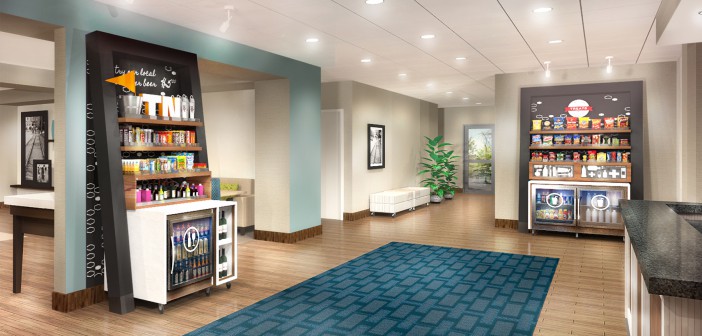The pantry of today is relevant, customer-focused and very profitable when well-managed.
by BOBBY MARTYNA
While many luxury hotels feature walk-in gift shops, thousands of select-service hotels and an increasing number of full-service hotels feature lobby convenience stores, most often called The Pantry or The Market. In contrast to traditional gift shops, which are typically leased to third parties during daytime hours, pantries features snack options, light fare and midnight meals. They’re also hotel owner/operated with 24/7 availability.Here we’ll discuss how leading hotel owners design, configure and operate them, and why the managed pantry concept is the most efficient method to capture the value of the retail space.
The evolution of the concept
For many years after the introduction of the off-the-front-desk retail concept, pantries were considered by owner/operators to be either a guest amenity or an oversized vending machine. The retail part of the business was reported as an expense and was deemed to be non-core to hotel operations.
Additionally, the retail business was not considered part of food and beverage (F&B), wasn’t a significant revenue source, and was ignored by finance and operations. The brands had defined and deployed a very interesting retail concept into the hospitality industry, but the operations side of the retail business was ill-considered. During this period, pantries suffered from serious neglect.
Streamlining and business traveler needs
The situation began to change about 10 years ago as new innovations were introduced. Consolidated e-commerce ordering and direct-to-lobby delivery of small quantities replaced the arduous trip to the club store by front desk managers. Phone calls and fax orders to a half dozen vendors and painful invoice reconciliation was replaced by a single point for ordering, billing and customer service.
The renewed interest in pantries accelerated during and after the Great Recession as RevPAR and ADRs declined and owners sought new sources of revenue and cash flow. During the same time, corporations naturally reduced their expense accounts resulting employees spending less on restaurant dining. This further heightens the importance – and convenience – in hotel pantries for the budget-conscious business traveler.
The emergence of the well-managed pantry
These developments encouraged leading hotel brands and astute hotel owners to recognize that the lobby retail space could, in fact, generate both room-sized financial results and higher guest satisfaction if it were properly managed. They recognized that strong results from pantries could not be generated by sending an associate to the club store, buying from the vending wholesaler or from the buying group broadliner.
Ad hoc buying and setting items on the shelf while hoping for the best wouldn’t work, hotel managers had neither the time nor the expertise to do retail right.
The recognition that a truly managed pantry, which leverages expertise in the art and science of retail, has now come to the forefront and is considered to be among best practices in hospitality. The pantry of today and the future is relevant, customer-focused and very profitable when well-managed.
The managed pantry: it’s all about execution
While it is clear that pantries and markets can generate room-sized revenues and profits (generally the same gross profit as selling one to three rooms at the ADR), that’s only the potential. As always, it is execution makes the difference between success and failure.
Pantries have gotten traction as a hybrid between a hotel manager do-it-yourself model and the outsourced model, which provides hotel owners and managers the advantages of both but with none of the deficiencies. Under the managed pantry concept, hotel managers need to stock the shelves and check out the guests, and everything else is done by firms specializing in hotel retail.
When well-managed, these revenue-generating retail spaces play an important role in increasing guest satisfaction, revenues and profits, and is a net contributor to operating income (NOI). Leading hotel owner/operators are selecting vendors with a strong focus on driving portfolio results through deployment of a managed pantry program throughout their portfolios. ■
Bobby Martyna is co-founder, president and CEO of Tradavo. Tradavo has been designing, developing and deploying successful retail solutions for brands, owners and operators in the hospitality industry. Founded in 2006, Tradavo is a fast-growing, award-winning innovator and leading provider of managed pantry solutions in the U.S. To learn more, visit www.tradavo.com.
Considerations for the well-managed model
To get the most out of these retail food and beverage models, hoteliers should answer the following questions.
Conceptual design
Within the bounds of any brand constraints, what is the optimal design for the lobby retail, what is the space plan that works best for each lobby and how does it play into the overall lobby concept? Interior design, architectural details, materials palette as well as equipment selection all play an important role in creating an inviting guest experience.
Visual merchandising
What are the fixture arrangements that encourage guest engagement by providing both functional and beautiful merchandise presentation?
Category management
What are the categories that should be carried to meet the guest needs and desires and how are they placed within the retail space? How does the category vary by guest profile and ADR? And what are the seasonal changes?
Merchandise planning
What are the brand standards? What products should be carried, and how should each product be presented within the categories? What products, such as natural/organic, gluten-free or vegetarian choices, are required to meet guest needs?
Product sourcing
What is the best place to purchase the products at competitive prices? How many vendors are needed? How difficult is it to get long tail items onto the shelf?
Pricing
How should each item be priced “to market” while maximizing the profit potential? And how does the pricing model work within the overall goals for gross margins and SPOR?
Inventory management
The retail plan can be seriously degraded by out-of-stock conditions. What is the best method to ensure out-of-stocks are minimized or even eliminated? How is inventory kept up to date with minimal effort?
Retail finance and accounting
What is the budget for CapEx, and how do retail CapEx investments create value for owners? How is the accounting done for the retail part of the business? Is inventory accounted for properly? Can owners and managers view and roll up results by brand, region, owner, manager, etc.?
Do you have a food and beverage success story to share? Write to our editor at [email protected].




